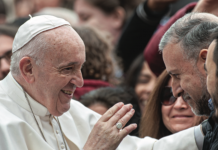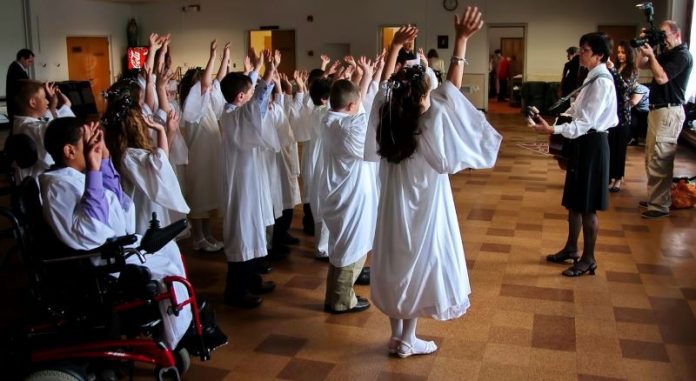
How do children and adults with disabilities learn about the faith and, especially, prepare
for the sacraments?
MAUREEN PRATT
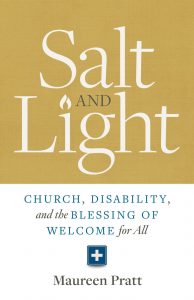 Excerpted from Salt and Light: Church, Disability, and the Blessing of Welcome for All, by Maureen Pratt.
Excerpted from Salt and Light: Church, Disability, and the Blessing of Welcome for All, by Maureen Pratt.
You shall love the Lord your God with all your heart, and with all your soul, and with all your might. Keep these words that I am commanding you today in your heart. Recite them to your children and talk about them when you are at home and when you are away, when you lie down and when you rise. Deuteronomy 6:4–7
The foundation of being able to participate in our faith is lifelong catechesis or learning: learning about God, church, history, the sacraments, personal spirituality, and life seen through the prism of Christian values.
We learn about our faith in different ways: through formal education; through regular attendance at Mass and other church events; through our own faith practices (prayer, meditation, and reading); and especially through our relationships with others. Sometimes, we learn through means handed down for centuries: the Lord’s Prayer, the Rosary, and the liturgy. But sometimes we need to have information “delivered” to us in newer, creative ways. This is true not only for persons with learning, developmental, or other disabilities; as the methods of conveying information change (from printed book to e-book, or from computer screens to cellphones), our capacity and way of receiving information changes and adapts. The more we consume information in tiny increments, for example, the shorter our attention span.
Very Special Education
I consider myself a very enthusiastic, committed Catholic Christian. But in childhood, I was plagued with serious illness; before I was eighteen, I’d had pneumonia thirteen times. This interrupted my education quite a lot and forced some creative learning. In first grade, I nearly got held back due to days missed! But fortunately, I managed to keep up with my homework and continue on with my classmates.
I wasn’t nearly as blessed when it came to catechesis, however. My formal religious education was very nearly derailed at age seven, when an unusual linguistic lapse surfaced: my brain just would not sync with my words. Every time I wanted to say, “first confession,” I said, “confirmation.”
It wasn’t that I didn’t have sufficient intellectual understanding; I knew what I wanted to say. And I was eager to receive the sacrament. But whether from laziness, mild dyslexia, or even the first signs of lupus brain fog, I constantly stumbled over those words.
There was no “special education” in those days, no “accommodation” for someone who learned well but sometimes differently. The rigorous curriculum for sacrament preparation demanded compliance, not deviance.
My mother, a religious education teacher at the parish, worked with me apart from the preparation classes. But even she had limited effect—some physical anomalies simply cannot be overcome in usual ways.
With the days rapidly passing, Mom finally said, “You’re not going to receive the sacrament until you can say it properly.”
“Can” became the operative word from then on: Mom didn’t say, “This is hopeless.” She knew I could do it, so I knew I could do it. Together we put aside the regular method of learning, prayed mightily, and found a technique that worked for me—a combination of word association, memorization, and visualization. I made it with my class to my first confession and sailed through to, yes, confirmation!
Words sometimes still escape me, a function of lupus brain fog that can be exacerbated by fatigue and other disease-related symptoms. But the early experience of overcoming my own deficits gave me confidence (and healthy humility) to know that this manifestation of my health condition has nothing to do with my ability to understand but only reflects how we are all “fearfully, wonderfully made.”
In the same way, the church community that opens itself to the possibility of sacramental preparation for all children, regardless of their disability, sparks potential for confidence, joy, and personal development that can lead to endless blessings. And, unlike when I was a struggling young Catholic, now, the “boxed in” methods of teaching have given way to possibilities for individual, effective instruction.
Adaptive Catechesis
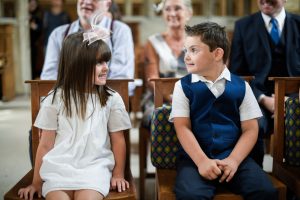 Amazing progress in understanding learning difficulties and teaching to and through them has enabled children and adults to learn much more effectively in the past few decades. The same diagnostic and educational techniques applied in academic settings are also being adapted in catechesis for persons with many different disabilities; children with Down syndrome, autism, Asperger’s, and other, often-complex disabilities are being introduced to Jesus and growing in understanding much more broadly than ever before. This is also enabling many more young Catholics (and adults, too) to participate in liturgy and in ministries, and to enjoy gathering as part of the entire church community.
Amazing progress in understanding learning difficulties and teaching to and through them has enabled children and adults to learn much more effectively in the past few decades. The same diagnostic and educational techniques applied in academic settings are also being adapted in catechesis for persons with many different disabilities; children with Down syndrome, autism, Asperger’s, and other, often-complex disabilities are being introduced to Jesus and growing in understanding much more broadly than ever before. This is also enabling many more young Catholics (and adults, too) to participate in liturgy and in ministries, and to enjoy gathering as part of the entire church community.
The October 2017 Conference on Catechesis and Persons with Disabilities: A Necessary Engagement in the Daily Life of the Church highlighted the work being done to creatively and carefully teach persons with learning, emotional, and developmental disabilities about God and the gospel. Educators, theologians, parents, and clergy from five continents shared their experiences working with children and adults with disabilities ranging from autism to Down syndrome. The consensus at the Conference was that, although each student presents particular needs regarding how they could learn and in what time-frame, there is no doubt that preparation for the sacraments is possible; moreover, their participation in the life of the church community can also be much more full.
“Catechesis, in a particular way,” said Pope Francis at the papal audience for participants in the Conference, “is called to discover and test congruent forms so that each person, with their gifts, limitations and even severe disabilities, can encounter Jesus on the journey and trustfully abandon themselves to Him. No physical or mental limitation should ever be an impediment to this encounter, because Christ’s face shines in the heart of each person.”
In practice, this kind of adaptive catechesis recognizes how someone learns and uses methods that correspond to that process. For example, a child with autism might not be able to process verbal language “normally,” but could perhaps learn by a combination of pictures and demonstrations; pictures and words, and color and texture could play an additional role in effectively communicating messages for the completely nonverbal.
Other accommodations could be used to teach other aspects of the faith. For example, sounds could be used creatively to help persons who are sight-impaired or blind to navigate the liturgy.
Attitudes play a key role in opening minds and hearts to the possibilities of adaptive catechesis. Parishes with no history of religious education for persons with special needs might not know where to begin. Some clergy might be dubious that a child or adult with a severe impairment could ever understand enough to be able to validly receive one or more of the sacraments. And parents themselves might doubt that their child is able or “worthy” enough to try.
An attitude of informed understanding and willingness is most effective from the “top down,” that is, from the pulpit to the pews. No faith community can have a successful catechetical program without the full support of its clergy. But there are resources that can be very helpful to all members of the church community, and it really doesn’t matter who gets the ball rolling, so long as it rolls! Here are some suggestions.
- Current parishioners who have experience and training in special education can speak up about the possibilities today’s teaching techniques present for effective catechesis to persons with disabilities.
- Parents of children with disabilities can teach skeptics about the successes that take place within special education programs in schools and show how these can be translated to catechesis.
- Published adaptive programs for specific disabilities (some are included in the Resources chapter of this book) can be purchased and reviewed for their content and feasibility for use in parish communities.
- Attention to safety and protection of minors is especially important regarding persons with disabilities. Sheila Hollins, of the Pontifical Council for the Protection of Minors, reminded us at the Conference that children with disabilities are at higher risk of abuse than those who do not have them, and adults with severe disabilities are also vulnerable.
- Programs in dioceses that serve as models for others, and information included on their websites, are excellent resources for parents, clergy, and religious education teachers to review.
Lifelong Catechesis
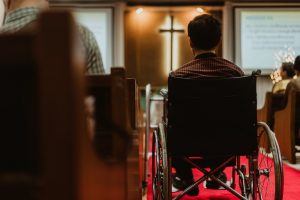 Preparation for the sacraments is a central task of catechesis. But learning about our faith and the ways it informs our lives takes place throughout our earthly journey, and persons with disabilities are just as eager to learn about the faith as those who do not have them. Church communities that offer ways for teens and adults to continue to acquire information about moral issues, church history, and other faith-centered subjects will strengthen the Spirit that moves in and among its members. And, church communities that offer some specific support for persons with ongoing disabilities and other chronic health conditions will be providing a much-needed and vital service. Here are some suggestions of what a faith community may provide:
Preparation for the sacraments is a central task of catechesis. But learning about our faith and the ways it informs our lives takes place throughout our earthly journey, and persons with disabilities are just as eager to learn about the faith as those who do not have them. Church communities that offer ways for teens and adults to continue to acquire information about moral issues, church history, and other faith-centered subjects will strengthen the Spirit that moves in and among its members. And, church communities that offer some specific support for persons with ongoing disabilities and other chronic health conditions will be providing a much-needed and vital service. Here are some suggestions of what a faith community may provide:
- targeted preaching on suffering, pain, and other subjects that relate to the experiences of persons with disabilities;
- spiritual support groups for adults with disabilities and chronic health conditions;
- written material that points to resources in the community for persons with disabilities;
- information about online and other accessible ways of continuing to learn about the faith, possibly degree and certificate programs;
- volunteer opportunities within the parish or community specifically for persons with disabilities, including training for becoming catechists;
- guest speakers and other parish-sponsored events that focus on one or more aspects of living with life’s challenges, including disability;
- prayer services, liturgies, or other worship events offered for persons living with disabilities and their families and caregivers (including medical professionals);
- opportunities that extend beyond parish boundaries—for example, remote prayer groups for persons in senior living or long-term care facilities, knitting or other craft groups that can make items to be donated along with other in-parish generated gifts, and webinars and online chats that can connect members in the parish with those who are confined to home.
Toward Full Participation
As we increase our knowledge and understanding of God, faith, and the opportunities to serve in the church, we cannot help but want to be more involved. How we do this will depend on our particular abilities, level of learning, and most especially our gifts and talents and how we develop them within the supportive and encouraging environment of our faith community. Some considerations:
- Persons with disabilities who volunteer in their churches should be held to the same standards of attendance and focus as others; emphasis is on serving the body and being present to God, not on showing off.
- Training should be available to and attended by persons with disabilities before engaging in service, especially liturgy. If necessary, this training, too, should be adapted to a person’s learning process (but the end result should be appropriate participation in the activity for which the training is given).
- Sometimes, a person with disabilities might perform certain functions at a slower pace than someone who is not disabled; this should not be a disqualifier but can be a blessing to a congregation, especially one that is usually hurried.
- As with all volunteers, persons with disabilities will respond well to encouragement, less well to irritation or criticism (a pet peeve of mine: even if preparation for the holidays brings extra stress, there’s no need to snap at volunteers!).
- If someone with a disability offers to serve, he or she should make every effort to appear respectful and appropriately attired, but there should be no consideration about how he or she “looks” with regard to visible disability, but rather only consideration of how he or she carries out that service.
- Whenever possible, everyone who serves should have the same kinds of name tags, vests, jackets, or other “gear” identifying them as volunteers or staff as others in the same capacity.
There is no reason why persons with disabilities cannot serve on committees and lead them, participate in liturgy at all levels (including music, and being a lector, greeter, or Eucharistic minister), join Catholic groups such as the Knights of Columbus, Daughters of Peter Claver, etc., and in all other ways practice the full richness of our wonderful faith. These and other opportunities within the body of Christ should be available to anyone with the requisite understanding, willingness, and joy to serve.
EDITOR’S NOTE: Excerpted from Salt and Light: Church, Disability, and the Blessing of Welcome for All, by Maureen Pratt. Copyright 2018. Published by Twenty-Third Publications (TwentyThirdPublications.com). Used with permission. All rights reserved. This is the chapter “Catechesis and Participation.”
Maureen Pratt has lived, studied, and written in the areas where faith, disability, and chronic pain and illness meet. A popular speaker, workshop leader, and author, her latest award-winning book is Salt and Light: Church, Disability, and the Blessing of Welcome for All.
Photos (T-B): Raymond Deleon, Shutterstock; Rawpixel.com, Shutterstock; MIA Studio, Shutterstock


